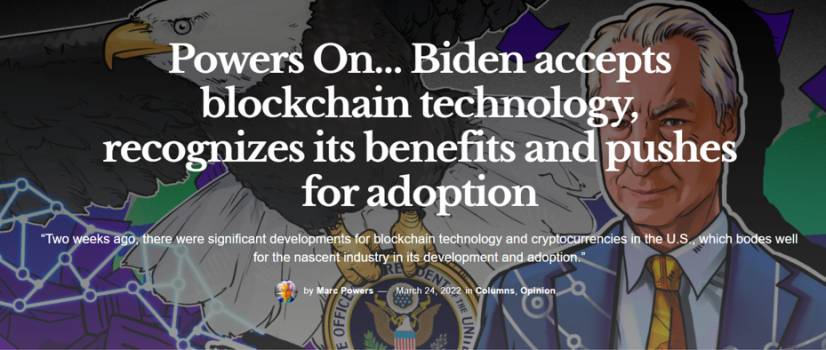K
Kathleen Martin
Guest
President Biden issued his executive order in a surprising act of executive power. No one quite expected it to occur the way it did, with most thinking that legislative action would be proposed sometime this year. I do not recall reading anywhere that an executive order, particularly without legislative action, would be proposed. Rather, our president instantly outtrumped — pardon the poorly crafted pun — former Vice President Al Gore, who under President Bill Clinton in the 1990s became a point man in the administration’s adoption and support of the internet. By the very act of issuing the executive order, President Biden will forever be recognized as the U.S. president who materially advanced the technology and its various use cases.
An overarching theme running through the executive order is the direction that various government departments and agencies coordinate, and that they do so in a relatively tight time frame by way of presenting reports. The president even ordered that each of the various governmental bodies investigate specific topics to be covered in the report. For example:
Remarkably, we also see an official acknowledgment of concern over, and a direction that the report consider, the fact that China has been seeking to disrupt the U.S. dollar’s global dominance as the world’s reserve currency with its digital yuan projects over the past several years. The executive order requests that the report discuss ways “foreign CBDCs could displace existing currencies and alter the payment system in ways that could undermine United States financial centrality [emphasis added].” In other words, what should the U.S. be doing to protect the dollar’s reserve currency status?
The president also encourages the chairman of the Board of Governors of the Federal Reserve System, Jay Powell, to continue to research and report on CBDCs and develop “a strategic plan […] that evaluates the necessary steps and requirements for the potential implementation and launch of a United States CBDC [emphasis added].” Then, in consultation with the attorney general and the secretary of the Treasury, Powell is asked to within 180 days offer “an assessment of whether legislative changes would be necessary to issue a United States CBDC.” If this does not make clear that this administration wants action in implementing an American CBDC — and in short order — then nothing will. As my friend Troy Paredes, a former SEC commissioner, observed during Inveniam’s excellent “Data 3.0 For Web 3.0” conference in Miami this month, the executive order not only recognizes the risks of digital assets but also the benefits of blockchain technology.
Continue reading: https://cointelegraph.com/magazine/2022/03/24/powers-on-biden-blockchain-benefits-adoption
An overarching theme running through the executive order is the direction that various government departments and agencies coordinate, and that they do so in a relatively tight time frame by way of presenting reports. The president even ordered that each of the various governmental bodies investigate specific topics to be covered in the report. For example:
Central bank digital currency“Within 180 days of the date of this order, the Secretary of the Treasury, in consultation with the Secretary of State, the Attorney General, the Secretary of Commerce, the Secretary of Homeland Security, the Director of the Office of Management and Budget, the Director of National Intelligence, and the heads of other relevant agencies, shall submit to the President a report on the future of money and payment systems, including the conditions that drive broad adoption of digital assets; the extent to which technological innovation may influence these outcomes; and the implications for the United States financial system, the modernization of and changes to payment systems, economic growth, financial inclusion, and national security.”
Remarkably, we also see an official acknowledgment of concern over, and a direction that the report consider, the fact that China has been seeking to disrupt the U.S. dollar’s global dominance as the world’s reserve currency with its digital yuan projects over the past several years. The executive order requests that the report discuss ways “foreign CBDCs could displace existing currencies and alter the payment system in ways that could undermine United States financial centrality [emphasis added].” In other words, what should the U.S. be doing to protect the dollar’s reserve currency status?
The president also encourages the chairman of the Board of Governors of the Federal Reserve System, Jay Powell, to continue to research and report on CBDCs and develop “a strategic plan […] that evaluates the necessary steps and requirements for the potential implementation and launch of a United States CBDC [emphasis added].” Then, in consultation with the attorney general and the secretary of the Treasury, Powell is asked to within 180 days offer “an assessment of whether legislative changes would be necessary to issue a United States CBDC.” If this does not make clear that this administration wants action in implementing an American CBDC — and in short order — then nothing will. As my friend Troy Paredes, a former SEC commissioner, observed during Inveniam’s excellent “Data 3.0 For Web 3.0” conference in Miami this month, the executive order not only recognizes the risks of digital assets but also the benefits of blockchain technology.
Continue reading: https://cointelegraph.com/magazine/2022/03/24/powers-on-biden-blockchain-benefits-adoption

